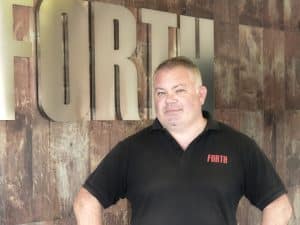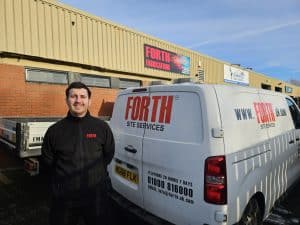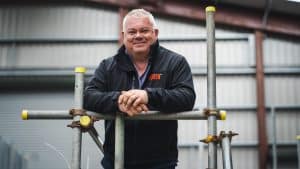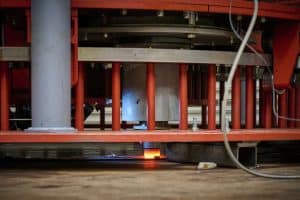AN ‘intelligent’ underwater autonomous survey robot fitted with sonar technology to detect and avoid obstacles so it can be used near critical infrastructure has been successfully showcased in a live demonstration.
Autonomous Aquatic Inspection and Intervention (A2I2) developed by a collaboration of companies from across the UK successfully completed its nuclear use case drop two trials at Forth’s Deep Recovery Facility in Cumbria.
The A2I2 collaborative R&D project, led by Rovco and supported by Innovate UK under the Industrial Strategy Research Fund, involves Forth, Rovco, D-RisQ, the National Oceanography Centre (NOC), Thales UK and The University of Manchester.
The project’s goal is to develop underwater autonomous vehicles which can improve safety and reduce the challenges of operating in hazardous environments, such as in storage ponds on nuclear sites.
Representatives from Sellafield Ltd and other End users attended the successful demonstration at Forth’s wet test facility at Maryport which, holding 1.2million litres of water, is one of the largest of its kind in the UK and enables businesses from a range of industries, including nuclear, oil and gas, marine and renewables, to carry out research and development, testing and demonstrations.
During a two-hour presentation and demonstration attendees saw A2I2 successfully move autonomously through the pond, avoid collisions, locate items on the pond floor and relay images which were able to be viewed, analysed and interpreted in real-time on screens nearby on dry land.
Rovco has been supporting each work stream with its groundbreaking, artificial perception technologies including 3D Computer Vision, Simultaneous Location and Mapping (SLAM), autonomous path planning and scene understanding using Machine Learning (ML). This Intelligent Data Collection System can be integrated onto any subsea vehicle to enhance its capability.
Gary Cross, Senior Robotics Engineer at Rovco, said: “The whole challenge of this particular project was removing people from hazardous and dangerous environments. One of the key things is increasing the distance between the operators and the environment they’re working in. And the easiest way to do that is to make the vehicle remote, remotely controlled and remotely operated.
“Some of the challenges you have, of course, is that as you increase the distance between the operator and the tools which they’re using, you have increased latency and other challenges which generally make it very difficult to to operate. So, technology such as the advanced perception system and mapping capabilities enables us to use the autonomy to provide the appropriate systems to the pilots who can still be controlled in a safe and meaningful way within the pond.”
Joe Tidball, Innovations Manager at Rovco, said: “The most significant technology I’ve seen in these trials was the autonomous ability to recreate a scene that hadn’t been seen by the robot before.
“The robots are able to go in with a sensor package, it’s got no prior knowledge of where it’s been before, and begin reconstructing that environment for future uses. It means that you don’t have to have a prior knowledge of the environment.
“This is fantastic in a decommissioning sense when you don’t necessarily know what is down there in the water. It means that you can start looking at removing people from what is a hazardous environment, putting them on shore and making it safer and more efficient.”
Forth has incorporated sonar technology with the robot’s system to detect and avoid obstacles underwater to enable the robots to be used near critical infrastructure. Alongside this Forth has developed an enabling Lilypad technology which provides launch and recovery, recharging and high bandwidth communications for the ROV.
Forth’s Programme Manager Peter Routledge said afterwards: “Seeing things in a live demonstration is sometimes better than seeing a 3D image portrayed. People were able to see and ask various questions about how the SLAM technology and the Lilypad technology are brought together to pick out assets on the bottom of the pond so people can see the actual images on a live feed with no delay so people can make judgments in real time. That in itself portrays excellence through the technologies.
“You could then survey the same area in two months’ time and overlay the original image to see if you’ve removed the asset or if the asset is still there. That to me is one of the greatest developments of this demonstration.
“We’ve demonstrated looking at the pond floor but you could also use it on the pond wall, possibly for determining the length of radiation that’s in the pond wall. So, there’s various uses from the technology.
“I think that with further development, this can become a single modular approach. So, if somebody just needed the LRE (last response engine) capability to stop things colliding in ponds, then that is one aspect that could be used if you were looking for wireless technology.
“The Lilypad and SLAM technology could also be used in their own ways. So, the actual estates that it could be used on are huge and that is just within the NDA (Nuclear Decommissioning Authority) estate. Then you could use it across Europe and then globally. The deliverables from this project, and the escalation, could be fantastic.”
D-RisQ brings advanced automated software development tools to safety-critical, security-critical and business-critical systems developers. It has used these tools to develop high integrity, autonomous decision making, safety-critical software for this demonstrator that enables the autonomous operation in accordance with regulatory requirements.
Nick Tudor, CEO of D-RisQ, said: “There’s a number of different aspects of the technology that we’ve demonstrated from our perspective. We’ve demonstrated that we can alter the capability of the last response engine and soon to be trademarked as safety critical decision making software. And we’ve shown that we can be flexible in changing the way in which that behaves very quickly and be able to take in new sensors and new information and make a proper sound decision on that.
“We’ve also developed a safety summary for that safety case for the use of that software, and that complies with all the nuclear regulations and that’s been presented to Sellafield and crucially to the Office for Nuclear Regulation to have a look at.
“What happens next is having demonstrated all the various technologies with the vast majority of it integrated, and showing how it all works, we want to be able to develop something to go into one of the pools at Sellafield with all those technologies fully integrated onto a specific tasking vehicle. We see that happening within the next couple of months.”
The University of Manchester has been developing wireless underwater communications, to eliminate the need for a tether, allowing A2I2 to operate more freely in hazardous environments.
Chris Ballard, Robotics and Artificial Intelligence Manager at Sellafield Ltd, who attended the A2I2 drop two trials demonstration at Forth, said: “What we’ve seen so far with the technology in the way that this technology is advanced is absolutely fantastic. It just shows that we’ve got a very capable supply chain with some really clever people in the supply chain willing to help us satisfy our challenges. It’s a huge advancement from what we’ve seen in the previous drop trials.
“The benefit for us within Sellafield is we need to look at removing operators from these harsh environments. Typically, things are done through tele-operational controls. What we’re seeing demonstrated here is the potential for autonomous processes where we can map live environments. It enables us to see what’s going on in our harsh environments.
“It has also got the collision avoidance systems built in and the communications that we so desperately need from down within the pond. So it’s tackling a lot of different discrete areas for us to utilise within the business.
“We have bespoke challenges that we’re trying to help satisfy across the whole organisation at Sellafield. From my perspective, to give that crosscutting value, I’d like to start to extract each of these challenges and the tools that we’ve seen in this demonstration, and the elements of the tools that will help fit those challenges. What I’d like to do then is to drive each of these differently into different directions, but to give a wholehearted deployment for each of these within our facilities.”
Steven Martin, Business Change Manager at Sellafield Ltd, who also attended the demonstration, said: “What we have seen demonstrated is exciting. I’ve been involved in this programme for two years now, and one of the things I wanted to see from this demonstration, which we did see, was that this capability can define a point of interest. For instance in our legacy ponds we have to decommission and remove inventory. So it’ll be really useful for us to be able to define a data set and then for us to actually survey and prove accountability that we’ve got those items retrieved from the pond.
“I’ve worked on all the programmes with the companies, and this is the furthest we’ve got towards achieving the requirements we need for not only inspection intervention of items that we have within our facilities at Sellafield, but also taking that technology across the NDA estate and across the UK nuclear programmes as we move into decommissioning.”
Forth is keen to hear from businesses and organisations across a range of industries which would benefit from using its Deep Recovery Facility for research and development, testing, trials or demonstrations. Contact Peter Routledge for further information peter@forth.uk.com www.forth.uk.com










